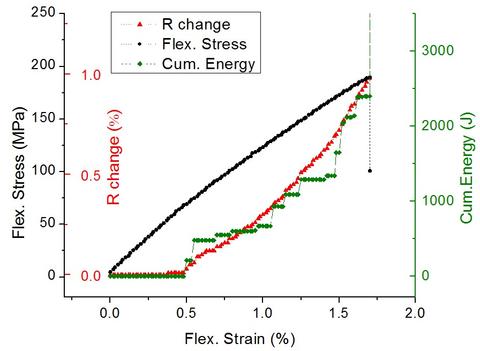Hierarchical Nanocomposite Durability

Figure 1: In-situ measurement of acoustic emission cumulative energy (green) and electrical resistance (red) during 1-point bend flexure testing (black) of a hierarchical composite.
The inclusion of nanomaterials at high volume fractions affects many aspects of long-term composite performance such as water transport, thermal management, and polymer matrix visco-elasticity/plasticity. Composite degradation potentially alters the electrical sensitivity of the nanomaterial network. In some cases, the inclusion of the nanomaterial into the composite accelerates the degradation rate in the composite. Understanding these complicated and dynamic mechanisms is important for commercial qualification of these materials and the development of failure prediction models. This project develops in-situ measurements for mechanical testing of fiber composites subjected to accelerated aging to allow multiple performance parameters to be quantified concurrently. One dominant method of integration of nanomaterials into a composite yields a surface studded with nanomaterials, giving the surface a “fuzzy” appearance under high magnification. The two main manufacturing methods of creating model systems of “fuzzy” fiber reinforcements are chemical vapor deposition (CVD) and electrophoretic deposition (EPD) . The STG develops advanced techniques to quantify moisture uptake, degradation chemistry, polymer viscoelasticity and nanomaterial structure that provide experimental details at length scales from the nanometer to the millimeter. The goal of this project to develop kinetic and physical models of the effect of the nanomaterials on long term performance.
Research opportunities may be found here.
RESULTS
We have performed a series of accelerated aging experiments on alumina fiber composites comprising CVD grown multiwall carbon nanotubes. We have shown that the nanotubes induce matrix microcracking at lower strains than composites without nanotubes. This cracking can be tracked by acoustic emission and electrical resistance measurements. While this microcracking may appear to introduce a weakness in the composite, but the carbon nanotube modified composites are much more resistant to failure from flexure testing after hydration in elevated temperature (60 °C) water than the composites without the nanotubes.
OUTSIDE COLLABORATOR
Brian Wardle, Massachusetts Institute of Technology
Erik Thostenson, University of Delaware
DATA DOI

